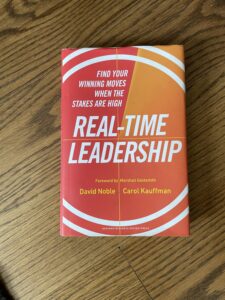 Improv. Diversity. Neuroplasticity.
Improv. Diversity. Neuroplasticity.
These three concepts are steeped into the new book Real-Time Leadership: Find Your Winning Moves When the Stakes Are High by two well-respected executive coaches, David Noble and Carol Kauffman.
However, the authors don’t explicitly reference these topics, not even as entries in the book’s index. Nor have I heard either author talk about them in Institute of Coaching (IOC) global coaching community sessions. (I’m an IOC member. Carol is one of the founders.)
Nevertheless, improv, diversity, and neuroscience shape the book’s research-based content in several positive ways. Here’s how:
Improv
Improv is a type of performance in which practitioners invent in the moment rather than follow written scripts that they practice in advance. Improv also describes the way organizational leaders have to deal with the uncertainty, disruption, and multiple stakeholders that they encounter today. It’s not possible for leaders to adhere to a script or even a playbook; the external environment, the interpersonal relationships, and challenges they face change too quickly.
Instead, as the authors explain, leaders need to learn how to create a space in real time to choose how to respond to fit the current situation they’re facing. Having space to think gives you a head start (yes, pun intended), but it isn’t enough to muscle through today’s complexity.
“The hardest part of leadership is mastering the inevitable high-risk, high-stake challenges you will face,” according to David and Carol. “The best leaders, in the biggest moments, know how to read the situation, respond in the most effective way possible, and move forward.”
Rather than tell you how to move, the authors share their MOVE framework – which is made up of many smaller frameworks within a larger structure. The authors’ expectation is that you will try out the various elements within MOVE, explore which ones work best for you as you encounter new situations, and adapt as needed. (This concept is similar to improv and its four rules; the rules provide you with firm footing as you move and stretch to adapt to your surroundings.)
As for real-time leadership, MOVE stands for:
- M: Be mindfully alert.
- O: Generate options.
- V: Validate your vantage point.
- E: Engage and effect change.
For example, being mindfully alert involves being clear about your external goals, your internal qualities, and your interpersonal challenges with others. For example, ask yourself these questions: “What does a win look like for what I want to achieve?;” “Who do I want to be right now?;” and “How do I need to best relate?”
For all of the MOVE letters, the authors describe the various sub-frames, explain how they work, offer questions to ask yourself, and also explain how to use the pattern recognitions they’ve developed throughout their many years of coaching. As a result, the content is extremely dense.
The value comes in reading the content carefully, absorbing it, reflecting on how you’d apply it in your real life, and then experimenting. It also helps to keep in mind the authors’ intent. Rather than telling you what to do, David and Carol want to help you think and act in more nimble ways, just as effect improv performers learn to do.
And if you’re interested in more about the similarities between improv and this method of leadership development, check out my blog post, How to improve your leadership skills by doing more improv.
Diversity
Thanks to many years of executive coaching, the authors have accumulated numerous enlightening stories that they include to illustrate how to evaluate and apply their frameworks. Even better, they feature a diverse range of leaders in their book in terms of industry experience, roles, backgrounds, and personalities.
These leaders who are using the MOVE framework include Cheryl, a consumer products CEO; Mateus, an innovative leader in Latin America who was being considered for a CEO role; Jake, who was the long-serving COO of a US food company who was promoted to CEO; Aria, the executive director of an international NGO; and Amanda, the CEO of a Fortune 250 company.
As a reader, it’s refreshing to come across a variety of individuals, not just the usual suspects found in musty business books.
Neuroplasticity
The third concept that’s integral to the book is neuroplasticity, or brain plasticity, which is the brain’s ability to rewire itself. For many years, adult brains were considered to be unchangeable. However, research has now shown that the brain is a fluid organ and can reorganize itself based on an individual’s lifestyle, behavior, and environment. In other words, how you think, what you do, and the environment you live in – all things in your control – can have a huge impact on the cognitive health of your brain.
So if you believe you can rewire your brain – in other words, you embrace neuroplasticity – you’ll be able to take the MOVE framework, adapt it to fit your situation, and become a much more flexible, adaptable leader.
And if you also embrace the research that shows that attitudes, mindsets, and emotions are contagious, you’ll be inclined to embody and model the behaviors and culture you want for your organization. And soon others will be following you.
You’ll be working in a more improvisational manner as you think better while you grow and develop to be your best.

0 Comments